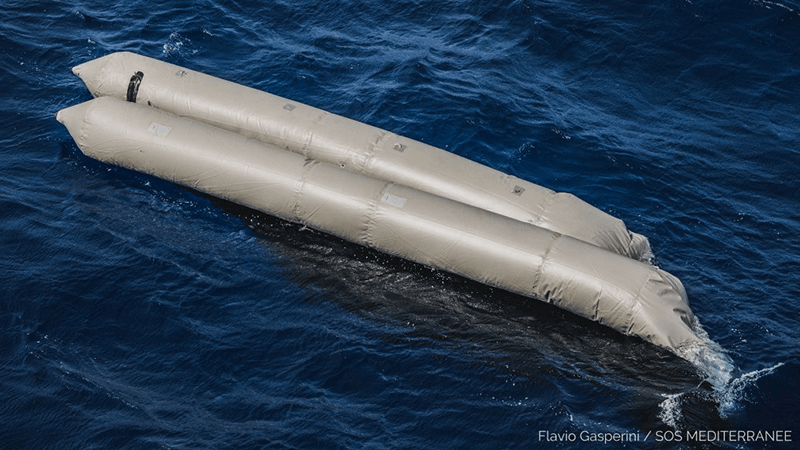There have been more than 3,400 deaths on migration routes to and within Europe in 2021, the highest number of recorded fatalities since 2016, according to the latest Missing Migrants Project (MMP) regional overview by the UN’s International Organisation for Migration (IOM).
Published last week, the report provides an overview of deaths during transit to and within Europe that the project was able to record between January and December 2021.
“We’ve recorded more than 29,000 deaths during migration journeys to Europe since 2014,” Julia Black, the author of the latest report, said in the project’s press release. She added that “these continuing deaths are another grim reminder that more legal and safe pathways to migration are desperately needed.”
According to the latest annual regional overview, although the deadliest migration route remains the Central Mediterranean crossing from Libya and Tunisia towards Malta or Italy, 2021 also marked an increase in deaths on many other European routes compared to prior years. These were notably on the land border between Turkey and Greece, the English Channel crossing, the Belarus-European Union (EU) borders and the Western Balkans route.
In the Central Mediterranean, more than 1,550 deaths were documented by MMP, and on the Western Africa-Atlantic route to the Spanish Canary Islands, more than 1,100 people lost their lives.
Between January and December 2021, 45 deaths were recorded on the English Channel crossing, including one shipwreck where the remains of 27 people were eventually recovered.
More than 96% per cent of all lives lost in the Central Mediterranean in 2021 were documented just off the North African coast, and less than four per cent of those deaths were registered off the coast of European countries. These included 56 people who died off the coast of Italy and three disappearances at sea in Malta’s Search and Rescue (SAR) zone.
While deaths on sea routes comprise the most significant death toll in MMP records on European routes, more than 55 deaths were documented at the Turkey-Greece land border in 2021, including 49 on the Turkish side. At least 17 of these deaths were related to alleged forced expulsions by the authorities (pushbacks), according to reports from survivors.
Reports from survivors relayed to IOM indicate that since 2021, at least 252 people have died during alleged forced expulsions by European authorities, also known as pushbacks.
The IOM underscored that deaths due to pushbacks are almost impossible to verify “due to the lack of transparency, access, and the highly politicised nature of such events. As such, these figures are likely an underestimate of the true number of deaths”.
Nevertheless, according to the latest report by the special rapporteur on the human rights of migrants, Felipe González Morales, pushbacks remain the de facto general policy in many states “which have now legitimised the practices either through the introduction of legislation and by means of government executive orders. Several states have recently used these tactics as a means to whitewash unlawful practices and to pursue them as a general policy, in some cases accompanied by public relations campaigns”.
Meanwhile, Malta continues to apply the deterrence tactic of being non-responsive to distress calls and refusing disembarkation. Most recently, Doctors Without Borders (MSF) criticised the inaction of Malta’s Armed Forces within its Search and Rescue (SAR) area after the NGO intervened to rescue 268 people from four boats in distress that the organisation says were within Malta’s search and rescue area.
The Missing Migrants Project report also recorded, for the first time in 2021, deaths at Belarusian borders, with 21 deaths documented during attempted crossings from Belarus to Poland, 12 of which occurred in Poland and nine in Belarus. These deaths were often preventable, such as those linked to sickness and a lack of access to healthcare, and another four were due to a lack of shelter during harsh weather conditions.
The Western Balkans route also claimed the most lives of any intra-European route monitored by MMP, with nearly 250 deaths documented since 2014 with more likely to be unrecorded. In 2021 MMP recorded 39 deaths on this route, including in Bosnia and Herzegovina (8), Croatia (8), Hungary (7) and Serbia (7).
The Missing Migrants Project collects data through official sources such as coast guards and local authorities, nongovernmental civil society organisations and focal points in IOM country offices, and media monitoring. However, the report acknowledges that data collection on migrant deaths and disappearances remains especially challenging due to the lack of systematic reporting. Moreover, even when available, official data is often incomplete.
Furthermore, unlike other regions where data limitations are due to a lack of capacity, the limited official reports on migrant deaths in Europe are complicated by the extreme politicisation (and polarisation) of migration issues.
The issue of ‘invisible shipwrecks’ also needs to be considered when looking at the available data. These are events that officials cannot corroborate because the vessels cannot be located or the information is insufficient. When officials learn about them, it is often through bereaved family members.
“There are people from 52 countries who have died on migration routes to and within Europe in our dataset,” concludes Black. “The scale of this issue – and the impact on families and communities dealing with unresolved losses – means there is no solution to this issue without buy-in from the authorities.”













So what? Are we to blame? Do you know how many millions upon millions of young european youths died im this continent fighting to get the Europe we have today in two great wars. You know how many women died in Malta under the ruins of their own home whist their husbuns died diffending little malta. These people should fight for freedom in their country and leave little Malta alone.